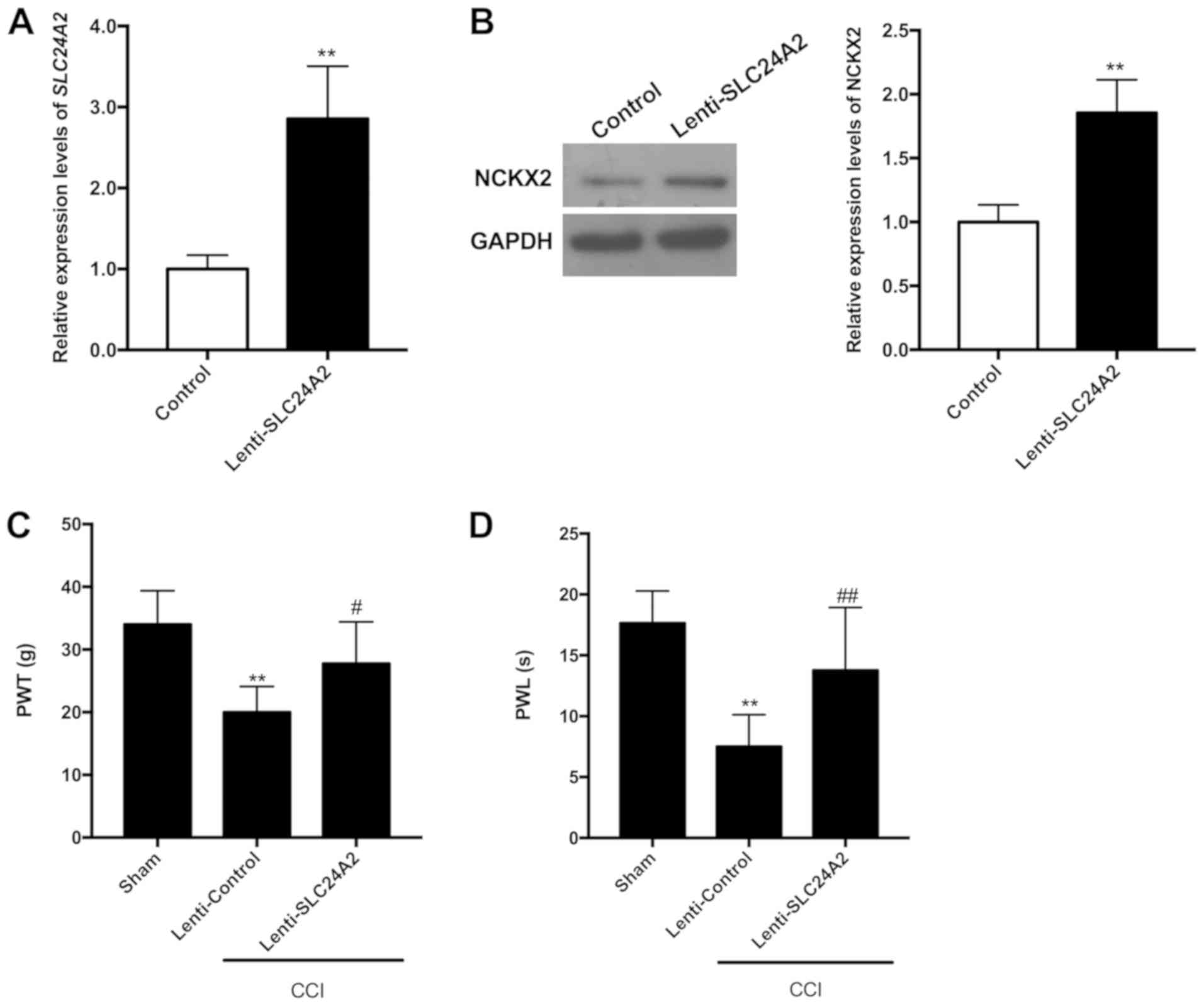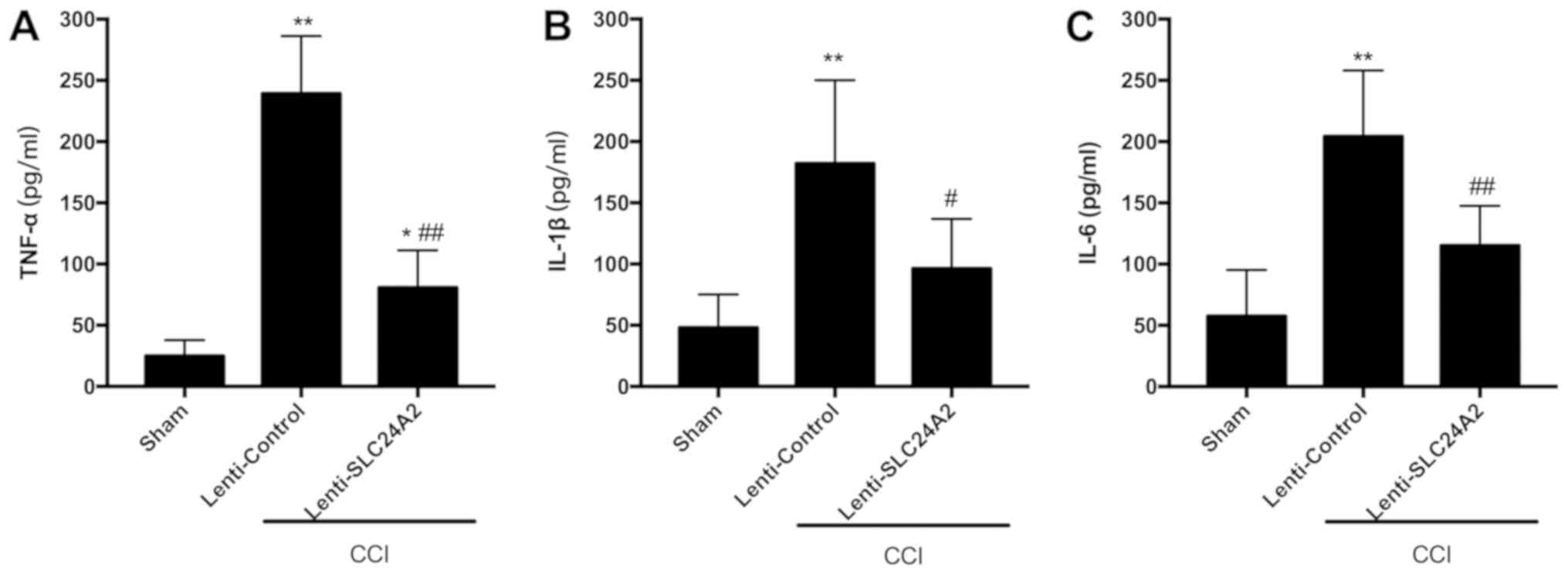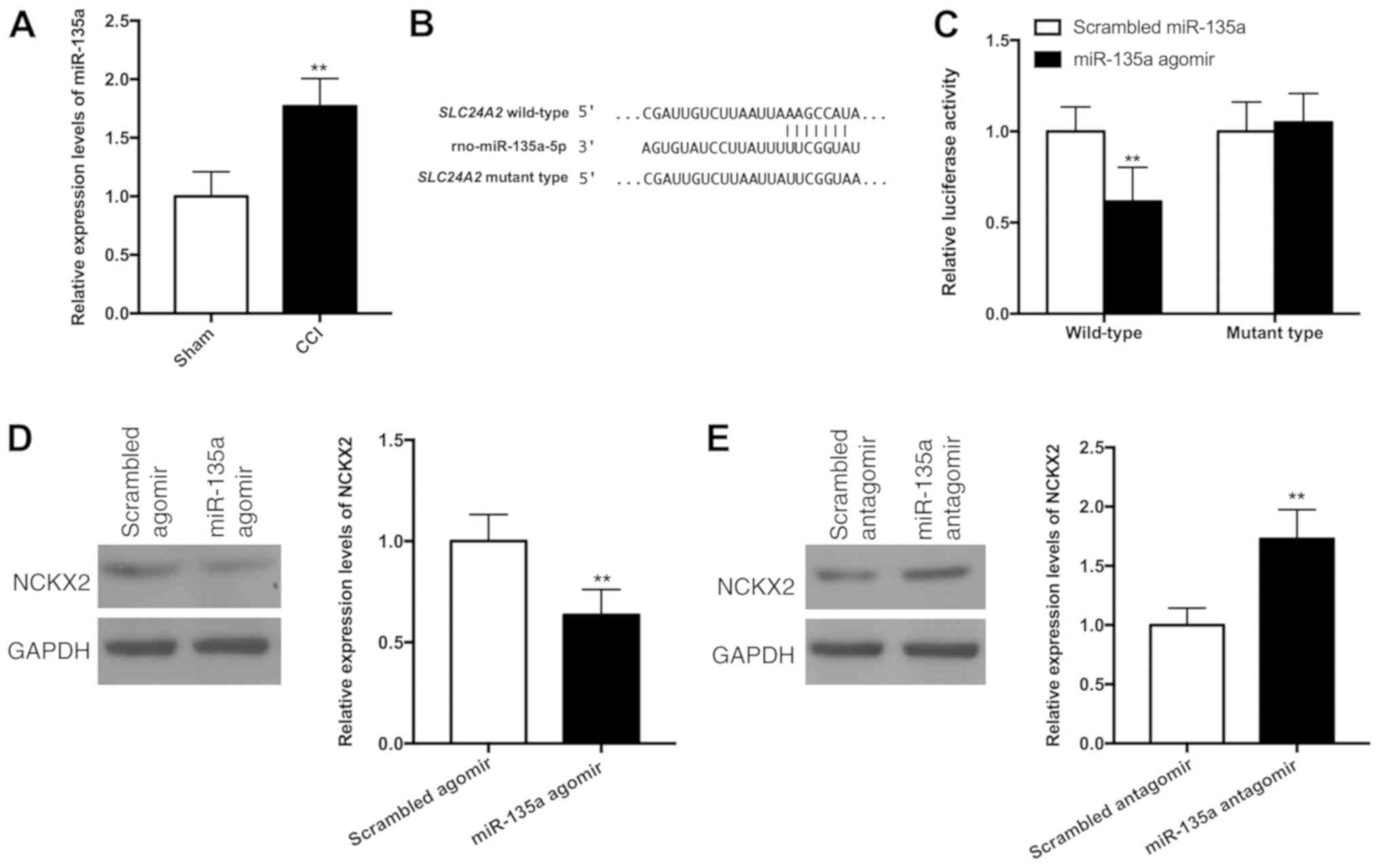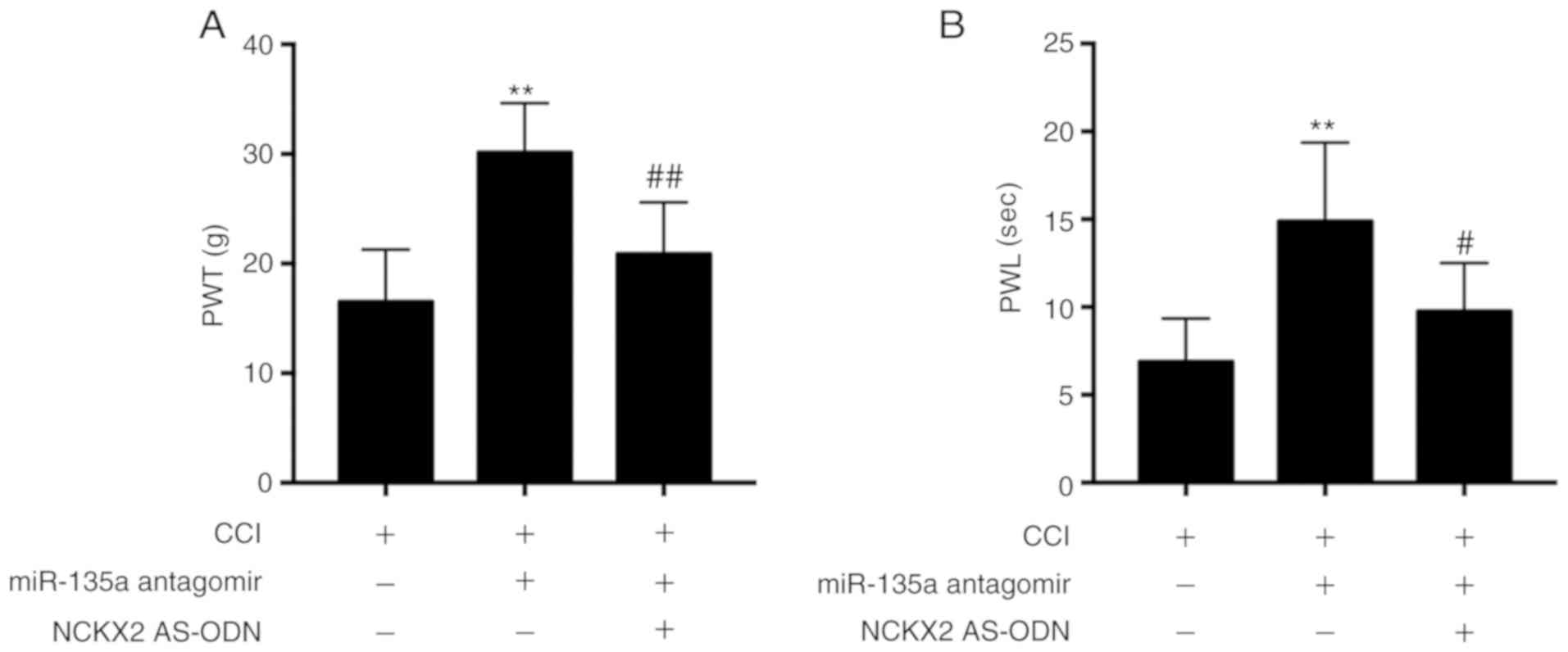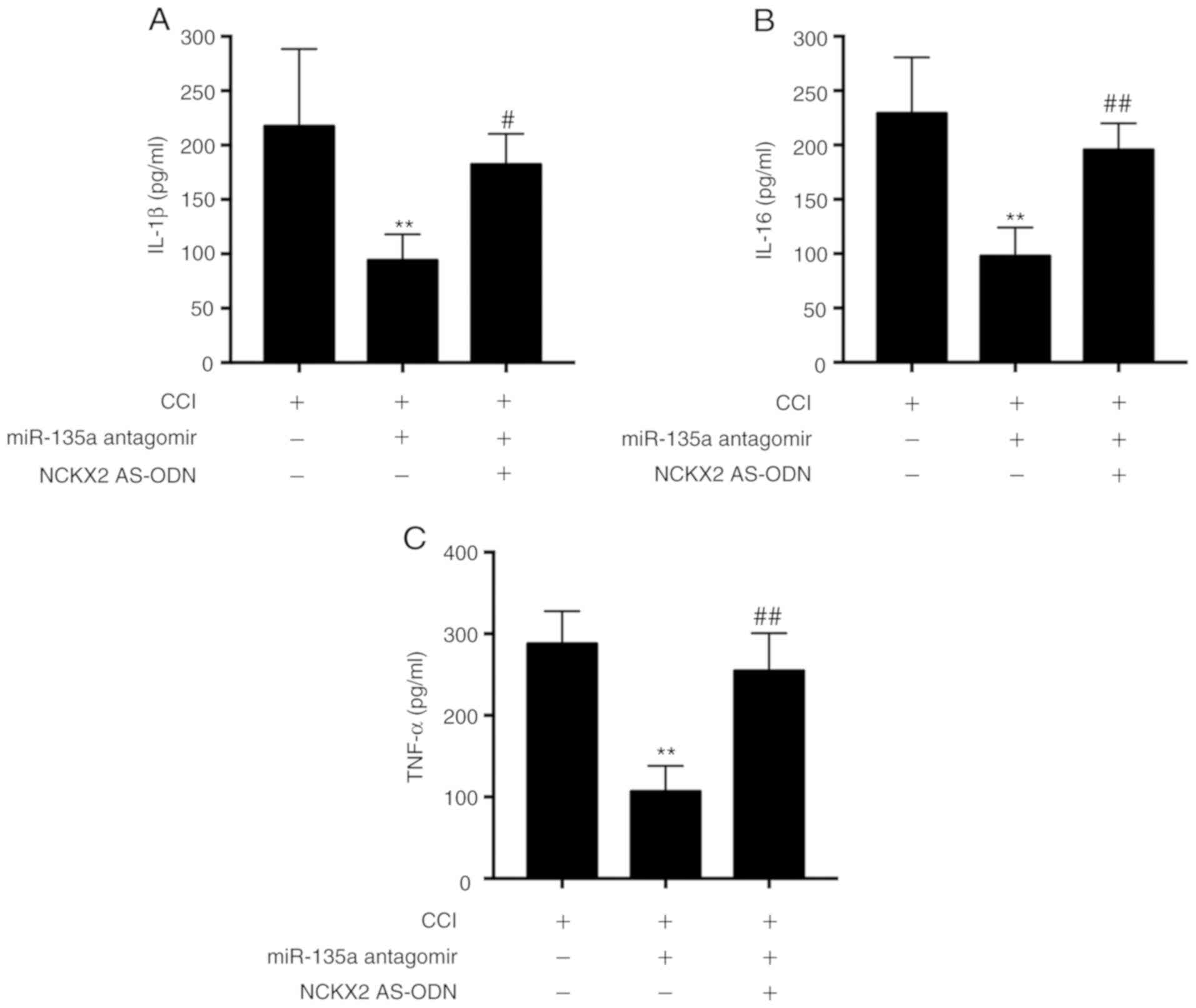Introduction
Neuropathic pain (NP) is a refractory and
long-lasting disease caused mostly by peripheral nerve injury,
which frequently occurs in patients with cancer, those treated with
radiochemotherapy or surgery, and patients with AIDS, lumbar disc
syndrome, and trauma (1). Although
the incidence of NP is high at ~6.9 to 10% in the general
population (2), its mechanism is
yet to be elucidated, and few effective methods can be used in a
complete and definitive way. Accumulating evidence suggests that
the dorsal root ganglion and spinal dorsal horn, the key nodes in
the pathway of peripheral pain information transmission, are
involved in peripheral nerve injury-induced NP (1–3).
Exploring the mechanism of molecular cytology changes in these
regions is of great significance for understanding neuralgia.
Most cellular processes and physiological functions
of neural cells, such as intracellular signal transduction, gene
regulation, protein modification, neurotransmitter release and
synaptic plasticity, rely on the ubiquitous messenger ionized
calcium (Ca2+) (4–6).
Previous studies have also demonstrated that the ontogeny of NP is
related to the alteration of Ca2+ in afferent neurons
through the regulation of a number of voltage-gated calcium
channels and an increase in Ca2+ influx (7–9). The
dynamics of intracellular Ca2+ are regulated by the
activity of a variety of calcium membrane channels and
transporters. Among these, Na+/Ca2+
exchangers, which mediate Ca2+ extrusion, play a
predominant role after neurons experience large Ca2+
fluxes (10,11). Na+/Ca2+
exchangers include two families: K+-independent
Na+/Ca2+ (NCX) and K+-dependent
Na+/Ca2+ (NCKX), and NCKX2, which is encoded
by solute carrier family 24 member 2 (SLC24A2) and is widely
expressed in the brain and spinal cord, is a member of the NCKX
family (12). Gene-targeted
knockout of NCKX2 resulted in motor learning and spatial working
memory deficits in mice, which were caused by changes in plasticity
at hippocampal Schaffer collateral-CA1 synapses (13). However, the roles of NCKX2 in the
process of NP are still unknown.
To this end, the chronic constriction injury (CCI)
model was used, and it was revealed that the expression of
SLC24A2 and its encoding protein NCKX2 were both
downregulated in the posterior horn of the spinal cord.
Overexpression of SLC24A2 could reduce pain sensitivity and
the expression of inflammatory cytokines in CCI rats. Using
bioinformatics analyses, luciferase reporter assays, and a series
of behavioral tests, it was demonstrated that the decrease in
SLC24A2 after CCI treatment was directly regulated by
increased microRNA (miRNA/miR)-135a-5p in the spinal cord.
Materials and methods
Animals and NP model
All experiments were approved by Ethics Committee of
the Second Affiliated Hospital of Soochow University (no. 2018012),
and strictly followed the guidelines of the National Institutes of
Health Guide for the Care and Use of Laboratory Animals (8th
edition). A total of 98 Sprague-Dawley male rats (8–10 weeks old),
supplied by the Experimental Animal Center of Soochow University,
were housed in a 22–24°C, 40–60% humidity, specific pathogen-free,
12-h light/dark cycle room, with free access to a standard rat diet
and water. The health and behavior of each group of rats were
observed daily. The CCI NP model was prepared as previously
described (14). Briefly, after
being anesthetized with isoflurane (3.5% induction, 2–2.5%
maintenance), both sides of the sciatic nerves of rats were exposed
and ligated with non-absorbable sutures at 4 sites, with an
interval of 1 mm. Sciatic nerves in sham rats were only isolated
without ligation, serving as a control. Zero, three and seven days
after surgery, the dorsal horn of spinal cords (L4-L6) were
harvested under narcosis (isoflurane, 2–2.5% maintenance) for
further analysis. Severely inert rats and those with the
experiments completed were euthanized immediately by 99.9% carbon
dioxide (the air replacement rate was 25% of the container volume
per minute) to avoid or alleviate unnecessary suffering or
distress. The absence of a heartbeat was used to verify the death
of animals.
Intrathecal injection
Rats were anesthetized with isoflurane (3.5%
induction, 1.5–2% maintenance), and fixed in the prone position.
Following conventional disinfection, atlantooccipital membranes
were exposed and a 1-cm length incision was made, then PE-10
polyethylene catheters were slowly implanted into the lumbar
interspace through it. Rats with motor function impairment were
excluded. Whether the operation was a success was confirmed by the
occurrence of bilateral hind limb paralysis after 2% lidocaine
injection. Recombinant Lenti-SLC24A2 (10 µl; Shanghai
GeneChem Co., Ltd.), miR-135a-5p agomir or antagomir (10 µM;
Guanzhou RiboBio Co., Ltd.) were injected through a microinjection
syringe, which linked with the intrathecal catheter, 72 h or 24 h
before surgery. NCKX2 antisense oligo-deoxyribonucleotide (AS-ODN)
(5′-CCAATGACTCGAATTAGCTT-3′, 140 µg/kg) was infused continuously
with an osmotic minipump (1 µl/h; RWD Life Science Co., Ltd.)
connected to an intrathecal catheter 24 h before surgery (15,16).
Behavioral tests
Mechanical pain was determined by paw withdrawal
threshold (PWT) in response to increasing mechanical pressure
created by the calibrated Electronic von Frey filament as
previously described (17). The
pressure for bilateral hind paw withdrawal was recorded and defined
as PWT. The cut-off was set at 50 g. The withdrawal threshold was
calculated as the average of three continuous tests, with at least
10 min between them. Thermal pain was evaluated by paw withdrawal
latency (PWL) in response to light radiant heat. Light was focused
on the plantar surface of the bilateral hind paws. The interval
between light onset and paw withdrawal was recorded and defined as
PWL. The cut-off time was set at 20 sec. The test was repeated at
least three times, with a 5-min interval between them, and the
average PWLs was considered as the threshold of thermal-evoked
pain.
Prediction of the direct binding
miRNAs to SLC24A2
Bioinformatics analyses were performed to determine
the miRNAs that directly bind to SLC24A2 using programs in
TargetScan (http://www.targetscan.org/vert_72/), miRanda
(http://www.microrna.org/microrna/getGeneForm.do),
miRDB (http://mirdb.org), PITA (https://genie.weizmann.ac.il/pubs/mir07/index.html)
and miRWalk (http://mirwalk.umm.uni-heidelberg.de).
Luciferase reporter assay
The 3′UTR of SLC24A2 carrying the wild-type
binding sites or mutant binding sites of the miR-135a-5p were
cloned into the pmirGLO dual-luciferase vector (Promega
Corporation). The vectors were transfected into 293T cells by
Lipofectamine® 2000 (Invitrogen; Thermo Fisher
Scientific, Inc.) with miR-135a-5p as well as agomir administration
(Guanzhou RiboBio Co., Ltd.). After 48 h, cells were harvested and
luciferase activity was detected using the Dual-Luciferase assay
system (Promega Corporation) according to the manufacturer's
instructions. The results were normalized to Renilla
luciferase activity and expressed as relative luciferase
activity.
Reverse transcription-quantitative PCR
(RT-qPCR)
RNA in lumbar dorsal spinal cord tissues were
extracted by TRIzol (Invitrogen; Thermo Fisher Scientific, Inc.).
Reverse transcription was performed using the PrimeScript RT
reagent kit for mRNA or MiScript Reverse Transcription kit for
miRNA (Qiagen, Inc.). An ABI PRISM 7500 real-time PCR system and
SYBR Premix Ex Taq II (Takara Biotechnology Co., Ltd.) for mRNA or
a MiScript SYBR-Green PCR kit (Qiagen, Inc.) for miRNA were used in
the PCR reactions. The following thermocycling conditions were used
for RT-qPCR: Initial denaturation at 95°C for 5 min; 40 cycles of
95°C for 15 sec and 60°C for 60 sec. GAPDH or U6 served as internal
controls, respectively. Primers used were as follows:
SLC24A2 forward (F), 5′-CTGGAGGAGCGAAGGAAAGG-3′ and reverse
(R), 5′-TGTGAAAGTTCTGGGGCTGAC-3′; GAPDH F,
5′-CAACTTTGGCATCGTGGAAGGG-3′ and R, 5′-CAACGGATACATTGGGGGTAGG-3′;
miR-135a-5p F, 5′-CTCCTAGGTATGGCTTTTTATTC-3′ and R,
5′-TCAACTGGTGTCGTGGAGTC-3′; U6 F, 5′-CTCGCTTCGGCAGCACA-3′ and R,
5′-AACGCTTCACGAATTTGCGT-3′. The relative expression of target genes
was calculated by the 2−∆∆Cq method (18).
Western blot analysis
Total protein of lumbar dorsal spinal cord tissues
was isolated by N-PER™ Neuronal Protein Extraction reagent (Thermo
Fisher Scientific, Inc.) with a protease inhibitor. The protein
concentration was determined by the Pierce™ BCA Protein assay kit
(Thermo Fisher Scientific, Inc.). Then, 20 µg protein was loaded
into each well and separated by 10% SDS-PAGE. Subsequently, the
protein blots were transferred onto PVDF membranes. After being
blocked by 5% bovine serum albumin (Beijing Solarbio Science &
Technology Co., Ltd.) for 2 h at room temperature, the membranes
were incubated overnight at 4°C with the primary antibodies: Rabbit
anti-NCKX2 antibody (1:200; ab192419; Abcam) and GAPDH (1:4,000;
sc-25778; Santa Cruz Biotechnology, Inc.). The membranes were
washed and a horseradish peroxidase-conjugated goat anti-rabbit
secondary antibody (1:2,000; ab205718; Abcam) was added followed by
incubation at room temperature for 1 h. Finally, the membranes were
color developed with ECL (EMD Millipore). The gray value was
calculated by Quantity One software (version 4.5.0; Bio-Rad
Laboratories, Inc.) normalized to GAPDH.
Enzyme linked immunosorbent assay
(ELISA)
The protein expression of interleukin (IL)-1β, tumor
necrosis factor (TNF)-α and IL-6 in lumbar dorsal spinal cord
tissue homogenates were measured using commercially available ELISA
kits (SEKM-0002, SEKM-0034 and SEKM-0007; Solarbio Life Science),
according to the manufacturer's protocols. The experiment was
repeated three times, and the mean value was used.
Statistical analysis
SPSS (version 18.0; SPSS, Inc.) was used for data
analysis. Data were presented as the mean ± standard deviation.
Comparisons between two groups were estimated by a Student's
t-test, whereas multiple group comparisons were carried out by
one-way ANOVA analysis with a Bonferroni's post hoc test. P<0.05
was considered to indicate a statistically significant
difference.
Results
Expression of SLC24A2 in the dorsal
spinal cord is decreased after CCI
To investigate the association between
SLC24A2 and NP, RT-qPCR was used to examine the expression
levels of SLC24A2 in the dorsal spinal cord of rats after
CCI surgery. The results revealed that SLC24A2 expression
was significantly decreased in CCI rats compared with sham rats 3
and 7 days after surgery (P<0.05 and P<0.01, respectively,
Fig. 1A). Moreover, the expression
levels of the encoded protein (NCKX2) of the SLC24A2 gene
were determined 7 days after surgery by western blotting. It was
revealed that NCKX2 expression was also significantly decreased in
the lumbar dorsal spinal cord of CCI rats (P<0.05, Fig. 1B). These results indicated a
negative association between SLC24A2 expression and the
progression of NP.
Overexpression of SLC24A2 alleviates
NP
To determine the biological effect of SLC24A2
on NP, SLC24A2 was overexpressed in the dorsal spinal cord
of rats by intrathecal injection of lentivirus carrying
SLC24A2 (Lenti-SLC24A2). First, it was demonstrated
that the expression levels of SLC24A2 and its encoded
protein NCKX2 were both significantly increased in CCI rats treated
with Lenti-SLC24A2 (both P<0.01, Fig. 2A and B). Then, mechanical and
thermal pain responses were evaluated using behavioral experiments.
It was determined that mechanical allodynia and thermal
hyperalgesia were significantly enhanced in rats subjected to CCI
but alleviated by overexpressing SLC24A2 (P<0.05,
Fig. 2C and D). These results
indicated a suppressive role of SLC24A2 in NP.
Overexpression of SLC24A2 decreases
the expression of inflammatory cytokines
A previous study revealed that changes in calcium
concentration in cells could effectively regulate the inflammatory
response (19); therefore, the
biological effect of SLC24A2 on the expression of a number
of key inflammatory cytokines, which increase during the
development of NP, was subsequently investigated. It was revealed
that IL-1β, IL-6 and TNF-α were significantly increased in the
dorsal spinal cord of CCI rats, however their expression was
reversed in the Lenti-SLC24A2-treated group (P<0.05,
Fig. 3). The results indicated a
suppressive effect of SLC24A2 on neural inflammation.
SLC24A2 is a direct target gene of
miR-135a-5p
To determine whether the decrease in SLC24A2
after CCI was caused by miRNAs and identify the key regulator,
bioinformatics analyses were performed to predict the miRNAs that
directly bind to SLC24A2. All programs predicted that the
seed regions of miR-135a-5p could bind conserved sites in the 3′UTR
of SLC24A2 (Fig. 4B).
Moreover, it was revealed that the expression of miR-135a-5p was
increased in the CCI rats (P<0.01, Fig. 4A). Therefore, it was next
investigated whether miR-135a-5p directly interacts with the 3′UTR
of SLC24A2. The results revealed that co-transfection of
miR-135a-5p agomir with the luciferase vector containing the
SLC24A2 3′UTR with the wild-type miRNA binding site led to a
significant decrease in relative luciferase activity in 293T cells
(P<0.01, Fig. 4B and C).
However, when the binding site was mutated, the inhibitory effect
of overexpressed miR-135a-5p on relative luciferase activity was
blocked (P>0.05, Fig. 4B and
C). This result indicated that miR-135a-5p directly targeted
the 3′UTR of SLC24A2. Furthermore, the effect of up- or
downregulation of miR-135a-5p on NCKX2 expression was determined by
western blotting. The results revealed that miR-135a-5p agomir
treatment significantly decreased the protein levels of NCKX2 in
the dorsal spinal cord (P<0.01, Fig. 4D), and the miR-135a-5p antagomir
had the opposite effect on NCKX2 expression (P<0.01, Fig. 4E). In short, these results
indicated that SLC24A2 is a target gene of miR-135a-5p.
Downregulation of NCKX2 reverses the
suppressive effect of miR-135a-5p antagomir on NP
To determine whether miR-135a-5p regulates NP by
targeting SLC24A2, rescue experiments were performed by
co-infecting rats with miR-135a-5p antagomir and NCKX2 AS-ODN. The
results revealed that the suppressive effects of the miR-135a-5p
antagomir on mechanical allodynia (P<0.01, Fig. 5A) and thermal hyperalgesia
(P<0.01, Fig. 5B) were
significantly reversed by NCKX2 AS-ODN treatment. Moreover, the
decreased expression of the inflammatory cytokines IL-1β
(P<0.01, Fig. 6A), IL-6
(P<0.01, Fig. 6B) and TNF-α
(P<0.01, Fig. 6C) caused by the
miR-135a-5p antagomir was also reversed by NCKX2 AS-ODN. Overall,
these results indicated that miR-135a-5p exerted its effect on NP
by targeting SLC24A2 and its encoded protein.
Discussion
As an important Na+/Ca2+
exchanger, NCKX2 plays a significant role in intracellular calcium
clearance and participates in the process of key neurophysiological
functions (12,13). To the best of the authors'
knowledge, the present study is the first direct evidence that
NCKX2 plays a role in the pathologic process of neuralgia, and its
expression changes are directly regulated by miR-135a-5p.
NCXs and NCKXs are two major families of
Ca2+ plasma-membrane exchangers. The NCX family includes
three different gene products, NCX1-3, and exchanges
Ca2+ with Na+ in either direction to maintain
intracellular Ca2+ homeostasis (11). The NCKX family is composed of five
members, NCKX1-5, which differ from NCXs in their absolute
requirement for K+, and maintain mostly calcium
extrusion when the intracellular calcium concentration is >500
nM (20). NCKX2 is the major
isoform expressed in neurons (12,21).
A previous study demonstrated its physiological effects on
hippocampal synaptic plasticity and learning and memory functions
(13). In addition, a key role in
the pathogenesis of ischemic damage was also revealed in
NCKX2-knockout mice (16).
However, the roles of NCKX2 during NP have not been indicated. A
previous study suggested that NCX members in L4-6 dorsal root
ganglion neurons or other sensory neurons are involved in the
processes of spinal nerve ligation surgery or chemotherapy-induced
peripheral neuropathy pain (22).
These results indicated that NCKX2, another type of
Na+-Ca2+ exchanger, may also mediate the
pathological process of NP. As anticipated, in the present study,
using CCI pain models, a significant decrease in NCKX2 mRNA and
protein expression in the dorsal horn of the spinal cord was
revealed. Overexpression of NCKX2 could relieve the hyperalgesia of
rats in thermal and mechanical allodynia. To the best of our
knowledge, this is the first study investigating the effect of
NCKX2 on NP. Moreover, it was also demonstrated that the roles of
NCKX2 in the development of NP may be exerted through regulation of
the release of key inflammatory cytokines, including IL-1β, IL-6,
and TNF-α. The changes in calcium concentration in cells can
effectively regulate the inflammatory response (19), which is important for the
occurrence of NP. Thus, blocking the release of inflammatory
cytokines by enhancing Ca2+ extrusion by NCKX2 may be
effective for NP treatment in the future. NF-κB is also an
important factor in inflammatory processes and involved in the
neuropathic pain (23). Whether
NF-κB can be regulated by NCKX2 was not determined in the present
study, however in a following study, experiments will be performed
to elucidate their association.
In the present study, using a series of
bioinformatics analyses, luciferase assays, and behavioral studies,
it was further elucidated that the downregulation of NCKX2 during
the progression of NP was related to the upregulation of
miR-135a-5p. miR-135a-5p is a highly expressed miRNA in the nervous
system (24–29). Mannironi et al (24) reported a physiological role for
miR-135a in the modulation of presynaptic mechanisms of
glutamatergic neurotransmission and a previously unknown mechanism
in the amygdala for regulating anxiety-like behavior. In addition,
the roles of miR-135a in some nervous system diseases, such as
malignant glioma, Alzheimer's disease, Parkinson's disease,
cerebral ischemia and temporal lobe epilepsy, have also been
demonstrated (25–29). There are few studies revealing the
relationship between miR-135a-5p and the pathogenesis of pain.
Using miRNA-sequencing analysis of blood samples, Linnstaedt et
al (30) indicated that the
upregulation of miR-135a-5p may be related to persistent pain after
motor vehicle collision. In the present study, it was further
demonstrated that miR-135a-5p upregulation was involved in NP and
that downregulating miR-135a-5p could effectively alleviate
mechanical and thermal hyperalgesia. In addition, the increased
expression of IL-1β, IL-6 and TNF-α in CCI rats was reversed by
regulating the expression of miR-135a-5p, and all these roles were
demonstrated to be NCKX2-dependent. These results indicated that
miR-135a-5p and its target gene, SLC24A2, could be developed
into novel effective drug targets for NP treatment.
In conclusion, using the CCI model, it was revealed
that miR-135a-5p inhibited the expression of NCKX2 in the dorsal
root of the spinal cord and was involved in the progression of NP.
Selective regulation of miR-135a-5p or NCKX2 expression could
effectively relieve neuralgia. Additional studies should be
performed in other pain models to further demonstrate the universal
effects of miR-135a-5p or NCKX2 on other types of pain. Moreover,
the upstream regulatory factors for miR-135a-5p changes and the
downstream effective targets of NCKX2 in the pathogenesis of pain
should also be investigated.
Acknowledgements
Not applicable.
Funding
The present study was supported by the Key
Laboratory of Hand Function Reconstruction, Ministry of Health
(grant no. 17DZ2270500), the Key Research and Development projects
of Jiangsu Province (grant no. BE2018656), the Suzhou Municipal Key
Laboratory of Peripheral Nerve Injury Repair Foundation (grant no.
SZS201720), and the Key Clinical Diseases Project of Suzhou (grant
no. LCZX201708).
Availability of data and materials
The datasets used and/or analyzed during the current
study are available from the corresponding author on reasonable
request.
Authors' contributions
XGZ and PJW designed the study and wrote the
manuscript. XGZ and HH performed the experiments and statistical
analysis. All authors read and approved the final manuscript.
Ethics approval and consent to
participate
All experiments were approved by Ethics Committee of
the Second Affiliated Hospital of Soochow University (approval no.
2018012), and strictly followed the guidelines of the National
Institutes of Health Guide for the Care and Use of Laboratory
Animals (8th edition).
Patient consent for publication
Not applicable.
Competing interests
The authors declare that they have no competing
interests.
References
|
1
|
Colloca L, Ludman T, Bouhassira D, Baron
R, Dickenson AH, Yarnitsky D, Freeman R, Truini A, Attal N,
Finnerup NB, et al: Neuropathic pain. Nat Rev Dis Primers.
3:170022017. View Article : Google Scholar : PubMed/NCBI
|
|
2
|
van Hecke O, Austin SK, Khan RA, Smith BH
and Torrance N: Neuropathic pain in the general population: A
systematic review of epidemiological studies. Pain. 155:654–662.
2014. View Article : Google Scholar : PubMed/NCBI
|
|
3
|
Cohen SP and Mao J: Neuropathic pain:
Mechanisms and their clinical implications. BMJ. 348:f76562014.
View Article : Google Scholar : PubMed/NCBI
|
|
4
|
Nakamura Y, Reva M and DiGregorio DA:
Variations in Ca2+ Influx Can Alter Chelator-Based
Estimates of Ca2+ Channel-Synaptic Vesicle Coupling
Distance. J Neurosci. 38:3971–3987. 2018. View Article : Google Scholar : PubMed/NCBI
|
|
5
|
Li B, Tadross MR and Tsien RW: Sequential
ionic and conformational signaling by calcium channels drives
neuronal gene expression. Science. 351:863–867. 2016. View Article : Google Scholar : PubMed/NCBI
|
|
6
|
Bazargani N and Attwell D: Astrocyte
calcium signaling: The third wave. Nat Neurosci. 19:182–189. 2016.
View Article : Google Scholar : PubMed/NCBI
|
|
7
|
Castro J, Harrington AM, Garcia-Caraballo
S, Maddern J, Grundy L, Zhang J, Page G, Miller PE, Craik DJ, Adams
DJ, et al: α-Conotoxin Vc1.1 inhibits human dorsal root ganglion
neuroexcitability and mouse colonic nociception via GABAB
receptors. Gut. 66:1083–1094. 2017. View Article : Google Scholar : PubMed/NCBI
|
|
8
|
Iftinca MC and Zamponi GW: Regulation of
neuronal T-type calcium channels. Trends Pharmacol Sci. 30:32–40.
2009. View Article : Google Scholar : PubMed/NCBI
|
|
9
|
Waxman SG and Zamponi GW: Regulating
excitability of peripheral afferents: Emerging ion channel targets.
Nat Neurosci. 17:153–163. 2014. View
Article : Google Scholar : PubMed/NCBI
|
|
10
|
Minami A, Xia YF and Zucker RS: Increased
Ca2+ influx through Na+/Ca2+
exchanger during long-term facilitation at crayfish neuromuscular
junctions. J Physiol. 585:413–427. 2007. View Article : Google Scholar : PubMed/NCBI
|
|
11
|
Lytton J: Na+/Ca2+
exchangers: Three mammalian gene families control Ca2+
transport. Biochem J. 406:365–382. 2007. View Article : Google Scholar : PubMed/NCBI
|
|
12
|
Jalloul AH, Szerencsei RT and Schnetkamp
PP: Cation dependencies and turnover rates of the human
K+-dependent Na+-Ca2+ exchangers
NCKX1, NCKX2, NCKX3 and NCKX4. Cell Calcium. 59:1–11. 2016.
View Article : Google Scholar : PubMed/NCBI
|
|
13
|
Li XF, Kiedrowski L, Tremblay F, Fernandez
FR, Perizzolo M, Winkfein RJ, Turner RW, Bains JS, Rancourt DE and
Lytton J: Importance of K+-dependent
Na+/Ca2+-exchanger 2, NCKX2, in motor
learning and memory. J Biol Chem. 281:6273–6282. 2006. View Article : Google Scholar : PubMed/NCBI
|
|
14
|
Yan XT, Ji LJ, Wang Z, Wu X, Wang Q, Sun
S, Lu JM and Zhang Y: MicroRNA-93 alleviates neuropathic pain
through targeting signal transducer and activator of transcription
3. Int Immunopharmacol. 46:156–162. 2017. View Article : Google Scholar : PubMed/NCBI
|
|
15
|
Cuomo O, Pignataro G, Gala R, Boscia F,
Tortiglione A, Molinaro P, Di Renzo G, Lytton J and Annunziato L:
Involvement of the potassium-dependent sodium/calcium exchanger
gene product NCKX2 in the brain insult induced by permanent focal
cerebral ischemia. Ann N Y Acad Sci. 1099:486–489. 2007. View Article : Google Scholar : PubMed/NCBI
|
|
16
|
Cuomo O, Gala R, Pignataro G, Boscia F,
Secondo A, Scorziello A, Pannaccione A, Viggiano D, Adornetto A,
Molinaro P, et al: A critical role for the potassium-dependent
sodium-calcium exchanger NCKX2 in protection against focal ischemic
brain damage. J Neurosci. 28:2053–2063. 2008. View Article : Google Scholar : PubMed/NCBI
|
|
17
|
Yan T, Zhang F, Sun C, Sun J, Wang Y, Xu
X, Shi J and Shi G: miR-32-5p-mediated Dusp5 downregulation
contributes to neuropathic pain. Biochem Biophys Res Commun.
495:506–511. 2018. View Article : Google Scholar : PubMed/NCBI
|
|
18
|
Livak KJ and Schmittgen TD: Analysis of
relative gene expression data using real-time quantitative PCR and
the 2(−∆ ∆ C(T)) Method. Methods. 25:402–408. 2001. View Article : Google Scholar : PubMed/NCBI
|
|
19
|
Sama DM and Norris CM: Calcium
dysregulation and neuroinflammation: Discrete and integrated
mechanisms for age-related synaptic dysfunction. Ageing Res Rev.
12:982–995. 2013. View Article : Google Scholar : PubMed/NCBI
|
|
20
|
Schnetkamp PP, Jalloul AH, Liu G and
Szerencsei RT: The SLC24 family of K+-dependent
Na+-Ca2+ exchangers: Structure-function
relationships. Curr Top Membr. 73:263–287. 2014. View Article : Google Scholar : PubMed/NCBI
|
|
21
|
Jalloul AH, Szerencsei RT, Rogasevskaia TP
and Schnetkamp PPM: Structure-function relationships of
K+-dependent Na+/Ca2+ exchangers
(NCKX). Cell Calcium. 86:1021532020. View Article : Google Scholar : PubMed/NCBI
|
|
22
|
Huang Y, Wen LL, Xie JD, Ouyang HD, Chen
DT and Zeng WA: Antinociceptive effectiveness of the inhibition of
NCX reverse-mode action in rodent neuropathic pain model. Mol Pain.
15:17448069198645112019. View Article : Google Scholar : PubMed/NCBI
|
|
23
|
Wang L, Yin C, Liu T, Abdul M, Zhou Y, Cao
JL and Lu C: Pellino1 regulates neuropathic pain as well as
microglial activation through the regulation of MAPK/NF-κB
signaling in the spinal cord. J Neuroinflammation. 17:832020.
View Article : Google Scholar : PubMed/NCBI
|
|
24
|
Mannironi C, Biundo A, Rajendran S, De
Vito F, Saba L, Caioli S, Zona C, Ciotti T, Caristi S, Perlas E, et
al: miR-135a Regulates Synaptic Transmission and Anxiety-Like
Behavior in Amygdala. Mol Neurobiol. 55:3301–3315. 2018. View Article : Google Scholar : PubMed/NCBI
|
|
25
|
Gomez Zubieta DM, Hamood MA, Beydoun R,
Pall AE and Kondapalli KC: MicroRNA-135a regulates NHE9 to inhibit
proliferation and migration of glioblastoma cells. Cell Commun
Signal. 15:552017. View Article : Google Scholar : PubMed/NCBI
|
|
26
|
Nagaraj S, Zoltowska KM, Laskowska-Kaszub
K and Wojda U: microRNA diagnostic panel for Alzheimer's disease
and epigenetic trade-off between neurodegeneration and cancer.
Ageing Res Rev. 49:125–143. 2019. View Article : Google Scholar : PubMed/NCBI
|
|
27
|
Liu Y, Liao S, Quan H, Lin Y, Li J and
Yang Q: Involvement of microRNA-135a-5p in the Protective Effects
of Hydrogen Sulfide Against Parkinson's Disease. Cell Physiol
Biochem. 40:18–26. 2016. View Article : Google Scholar : PubMed/NCBI
|
|
28
|
Liu X, Li M, Hou M, Huang W and Song J:
MicroRNA-135a alleviates oxygen-glucose deprivation and
reoxygenation-induced injury in neurons through regulation of
GSK-3β/Nrf2 signaling. J Biochem Mol Toxicol. 32:e221592018.
View Article : Google Scholar
|
|
29
|
Vangoor VR, Reschke CR, Senthilkumar K,
van de Haar LL, de Wit M, Giuliani G, Broekhoven MH, Morris G,
Engel T, Brennan GP, et al: Antagonizing Increased miR-135aLevels
at the Chronic Stage of Experimental TLE Reduces Spontaneous
Recurrent Seizures. J Neurosci. 39:5064–5079. 2019. View Article : Google Scholar : PubMed/NCBI
|
|
30
|
Linnstaedt SD, Walker MG, Parker JS, Yeh
E, Sons RL, Zimny E, Lewandowski C, Hendry PL, Damiron K, Pearson
C, et al: MicroRNA circulating in the early aftermath of motor
vehicle collision predict persistent pain development and suggest a
role for microRNA in sex-specific pain differences. Mol Pain.
11:662015. View Article : Google Scholar : PubMed/NCBI
|
















